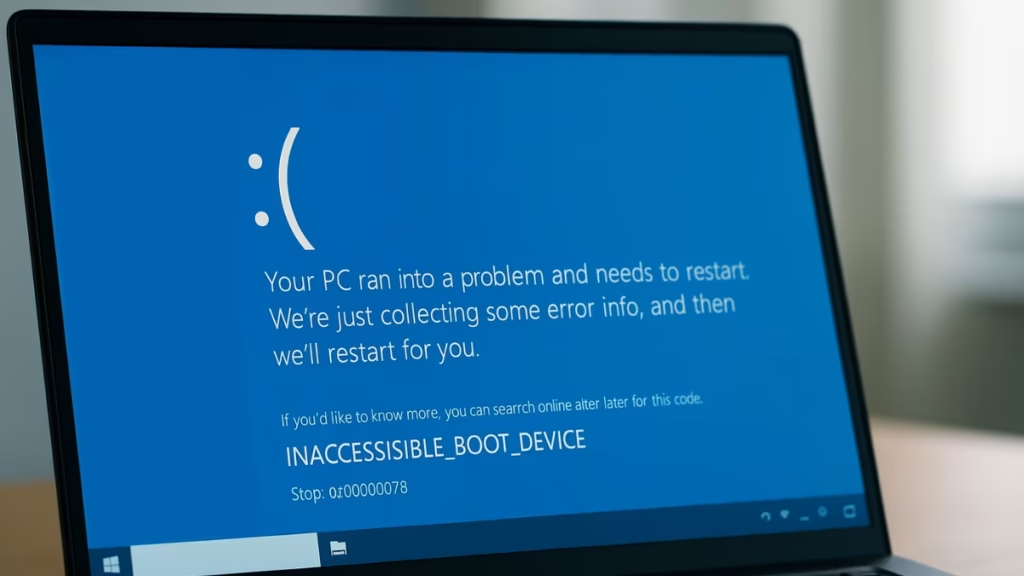When migrating Windows Server 2012 R2 virtual machines (VMs) to a Windows Server 2025 Hyper-V cluster, several administrators have reported that their VMs refuse to boot, showing a blue screen with the error code 0x7B (INACCESSIBLE_BOOT_DEVICE).

If you move the same VM back to the older cluster, it boots normally — which confirms that the issue lies with the Windows Server 2025 update level, not the VM itself.
What Causes the 0x7B Error on Hyper-V 2025
The root cause is a compatibility conflict introduced by newer Windows 2025 cumulative updates, particularly KB5060842.
This update changes how Hyper-V handles ACPI (Advanced Configuration and Power Interface) and storage bus drivers, which breaks older Windows 2012 R2 VMs that depend on legacy device mappings.
Affected environments typically show:
- Working 2012 R2 VMs on older clusters with updates:
KB5058411, KB5058523, KB5054979 - Broken VMs on newer clusters with updates:
KB5063666, KB5062553, KB5056579, KB5059502, KB5060842
Even creating a new 2012 R2 VM from ISO doesn’t always help unless registry entries match those of a clean, fully updated build.
Fix #1 – Registry Repair in Recovery Mode
If your VM can enter Windows Recovery Environment (WinRE):
- Boot into Command Prompt inside the recovery console.
- Load the SYSTEM registry hive:
reg load HKLM\TempHive C:\Windows\System32\config\SYSTEM- Copy missing ACPI registry keys (these re-link Hyper-V’s virtual hardware identifiers):
reg copy HKLM\TempHive\ControlSet001\Enum\ACPI\VMBus HKLM\TempHive\ControlSet001\Enum\ACPI\MSFT1000 /s
reg copy HKLM\TempHive\ControlSet001\Enum\ACPI\Hyper_V_Gen_Counter_V1 HKLM\TempHive\ControlSet001\Enum\ACPI\MSFT1002 /s- Unload and reboot:
reg unload HKLM\TempHive
shutdown /r /t 0Result: The VM should now detect its virtual devices correctly and boot normally.
Fix #2 – Remove the Problematic Update (KB5060842)
If you can manage the host nodes directly:
- On one node in your Windows Server 2025 cluster, uninstall the update:
wusa /uninstall /kb:5060842- Reboot that node.
- Migrate the problematic 2012 R2 VM to that node.
- Boot the VM — it should start successfully.
Tip: Keep at least one node on an older build to host legacy VMs until Microsoft releases an official patch.
Fix #3 – Use an Older or Isolated Cluster Node
If uninstalling updates isn’t an option:
- Keep one Hyper-V 2025 node unpatched (pre-KB5060842).
- Assign that node exclusively to 2012 R2 VMs.
- Ensure new VMs (2022 or 2025) stay on updated nodes.
Alternative Workarounds
If the above doesn’t fit your setup:
- Convert the VM to Generation 2 and disable Secure Boot.
- Manually install Integration Services in the guest OS.
- For archival workloads, move the VM to a Server 2019 or 2022 host.
- Avoid applying cumulative updates until Microsoft confirms a fix.
How to Verify the Fix for Windows 2012 R2 VM Boot Error on Hyper-V 2025
After reboot:
- VM boots past the Windows logo without BSOD.
- Microsoft Virtual Machine Bus appears under Device Manager > System Devices.
- Registry path
HKLM\SYSTEM\CurrentControlSet\Enum\ACPIcontains MSFT1000 and MSFT1002 entries.
The Windows Server 2012 R2 0x7B boot failure on Windows 2025 Hyper-V is triggered by a compatibility bug in new cumulative updates.
Read More:
- How to Fix “Connection to Server Not Supporting” in Windows 11
- Fix: Can’t Turn On Network Discovery in Windows 11? Here’s How
- Fix “Something Happened to Your PIN” Windows Sign-In Error
- Fix Azure Login Error AADSTS5000225: “Sorry, We’re Having Trouble Verifying Your Account”
- Fix Netflix Stuck at 540p – Play Netflix in High Resolution
- Fix: Installation Failed in the SAFE_OS Phase Error (0xC1900101)
- Fix: Intel Extension 2.1.10105.19 update keeps reinstalling
- How to Fix Windows 11 25H2 Search Not Working After Update
- Fix: Enter Old PC Name in Windows Backup During File Transfer
By restoring ACPI registry keys or removing KB5060842, you can bring affected VMs back online quickly. Until Microsoft rolls out an official patch, use an older node or earlier build for legacy workloads.


